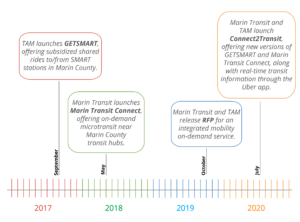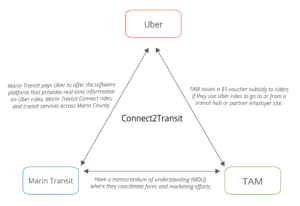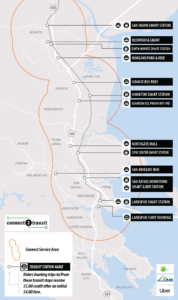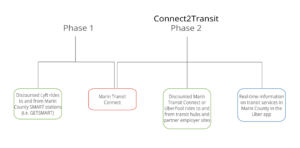Integrated Mobility Services with Connect2Transit, Marin County, CA
20 minutes Author: Shared-Use Mobility Center Date Launched/Enacted: Jul 1, 2020 Date Published: April 20, 2021
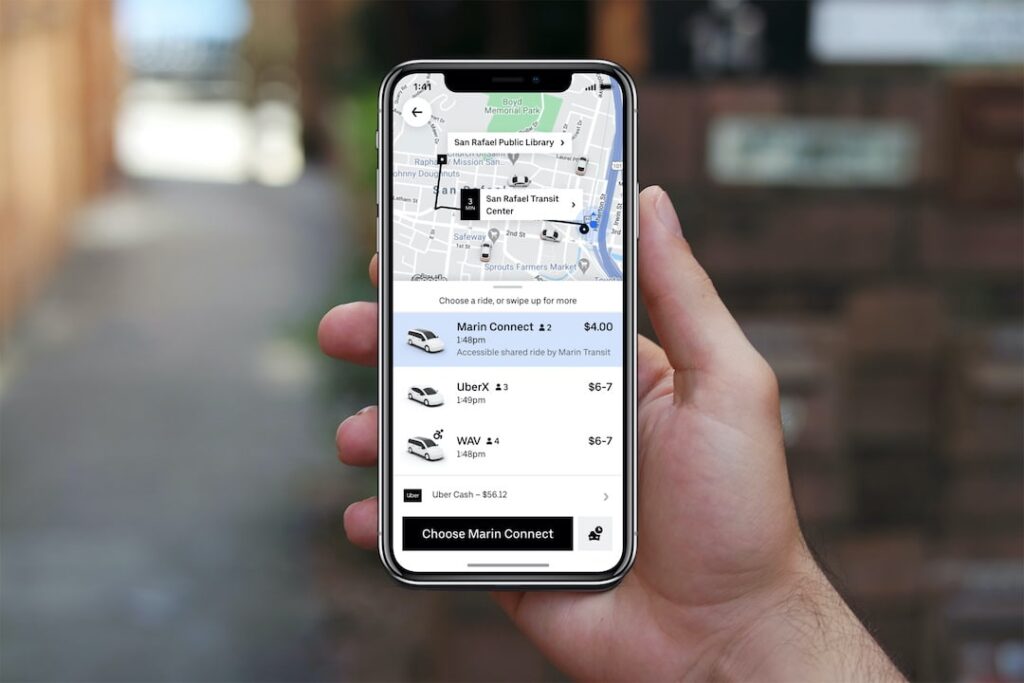
Brief Summary
- Marin Transit and the Transportation Authority of Marin (TAM) partnered to host a suite of mobility programs called Connect2Transit.
- Both Marin Transit and TAM transportation agencies operated separate iterations of these mobility programs beforehand. For this reason, staff at both agencies refer to Connect2Transit as Phase 2 and their pre-Connect2Transit programs as Phase 1.
- Uber, a transportation network company, serves as the technology vendor for Connect2Transit.
- Through Connect2Transit, customers can:
- Book same-day accessible microtransit rides on Marin Transit Connect;
- Request discounted Uber rides between large partner employers and transit stations, and;
- Access information in real-time for various transit services through the Uber app.
Introduction
In July 2020, the Transportation Authority of Marin (TAM) and Marin Transit introduced Connect2Transit, their most recent iteration of a Mobility on Demand program providing customers with a suite of options that can supplement their transportation journeys within Marin County. Connect2Transit brings together three components:
- Marin Transit Connect, an on-demand microtransit service.
- Discounted rides to and from transit and employment sites, jointly supported by Marin Transit Connect and TAM.
- Real time transit information for all transit providers in Marin County through the Uber app.
Originally, these programs were offered separately from one another, during a period that can be referred to as Phase 1; realizing a need to bring these programs into a more integrated format, Marin Transit and TAM released a request for proposals (RFP) seeking a technology solution for a Mobility on Demand effort. [1]
Description: Video interview with Cody Lowe from Marin Transit.
Credit: Shared-Use Mobility Center (SUMC)
This case study explores the history and context of Marin Transit and TAM’s Connect2Transit program, which is also referred to as Phase 2 (For more information on microtransit as a transportation mode, see SUMC’s Microtransit learning module). The Connect2Transit program offers a menu of transportation options for older adults, people with disabilities, and commuters across Marin County. At the same time, the Connect2Transit program delivers this integration through a single proprietary platform. It is important to consider the potential challenges and risks with this approach; while this case study does not go into detail on those measures, asking questions up-front and weighing them against the budget, long-term plans, and the ability for any technology platform to integrate across a system and its available mobility options are important considerations. Transportation agencies, municipal governments, and other stakeholders across the United States can use this case study to learn how they might adapt similar Mobility on Demand programs to their own communities and what technology solutions might best fit their needs.
History of the Program
Before Connect2Transit took its current form, two separate programs existed, both with similar goals of improving mobility options across Marin County. These Phase 1 programs included:
- GETSMART, launched by TAM, in September 2017. In partnership with the transportation network company, Lyft, TAM offered $5 subsidies for shared rides to and from SMART (Sonoma-Marin Area Rail Transit) stations within Marin County. As SMART only began its operations in 2017, the first-/last-mile program also served as a marketing effort for the new commuter rail itself. [2] In 2019, GETSMART averaged about 720 rides per month. [3] In January 2020, TAM announced an expansion of the program to include trips to and from two additional SMART stations. [4]
- Marin Transit launched Marin Transit Connect in May 2018 in partnership with Whistlestop (now Vivalon) as the operator provider and Via as the software platform provider. Riders could request shared microtransit/van rides anywhere within a designated area around transit hubs in Marin County through the Via app. Marin Transit Connect used four Ford Transit wheelchair accessible vehicles, purchased by Marin Transit through Section 5310 federal funds.
Although GETSMART was largely designed as a transportation demand management effort for commuters in Marin County, and Marin Transit Connect was created primarily for older adults and people with disabilities, their purposes and functions often overlapped. For example, both GETSMART and Marin Transit Connect had separate call centers for their respective programs under Phase 1. Ultimately, it made sense both logistically and financially for TAM and Marin Transit to partner and provide these services under one umbrella as customers could access all options through one app and one call center.
In October 2019, Marin Transit and TAM released an RFP for a Mobility on Demand software provider that could provide ride information for a joint Connect2Transit/Phase 2 effort that would collectively host new versions of both the GETSMART and the Marin Transit Connect programs. After reviewing bids from fifteen technology companies, planners overseeing Connect2Transit selected Uber as the technology partner based on the platform capabilities and the market reach of the company. The planners felt that the Uber app could functionally integrate both programs and that Uber’s name recognition could enhance marketing efforts for Connect2Transit customers.
In addition to giving customers the ability to request Connect2Transit rides through the Uber app, the integration of programs helped TAM and Marin Transit to consolidate their booking systems and call center functions. The Uber Central tool helps Marin Transit call center staff book rides for customers who do not have an Uber account, making Connect2Transit more accessible to older adults, people who need assistance, and those without smartphone access.
With the new agreement with Uber in place, the Marin Connect2Transit program began its operations in July 2020, providing microtransit rides and first-/last-mile connections to customers within a 2.5 mile radius of fourteen transit hubs in Marin County. It is important to note that because the program started during the COVID-19 pandemic, Uber’s shared-ride option, UberPool, is not available to Connect2Transit customers; instead, customers can use single-party Uber rides if they wish to receive a $5 discount from TAM for going to or from a transit hub.
Program Goals and Outcomes
Connect2Transit’s success as an initiative relies upon three partnership agreements:
- Marin Transit pays Uber to offer the software platform that provides real time information on Uber rides, Marin Transit Connect rides, and Marin Transit buses.
- TAM and Marin Transit have a memorandum of understanding (MOU) where they coordinate fares and marketing efforts.
- Uber and TAM have an agreement where TAM issues a $5 voucher subsidy to riders if they use Uber rides to go to or from a transit hub or partner employment site.
With these agreements in place between the three parties, Marin Connect2Transit has these goals in mind:
- Integration of transportation options into one app. Customers can get real time information, including fares and program subsidies where applicable, about the Marin Transit Connect microtransit service, Uber rides, and public transit options from Marin Transit, SMART, and Golden Gate Transit.
- Same-day accessible rides through Marin Transit Connect. Marin Transit Connect will continue to have a fleet of four, branded Ford Transit vans that can fit five seated passengers and two passengers using a wheelchair. [5] Marin Transit Connect is primarily marketed to older adults and people with disabilities. Through the suite of Marin Access programs, Marin Transit provides discounted rides to eligible participants; however, Marin Transit Connect vehicles are available to all individuals seeking rides within its service area.
- First- and last-mile ride options. Through the Uber app, residents and commuters in Marin County can request rides through Uber and Marin Transit Connect and get real-time information on transit options.
- Cost savings for Marin Transit and TAM. By consolidating their contracts with Via and Lyft into a single transportation technology contract with Uber, the Connect2Transit program is believed to save time, resources, and money for customers and staff operating the program.
- Partnership opportunities with employers in Marin County. Currently, two of the largest employers in Marin County, Kaiser Permanente and Marin County itself, provide additional rideshare vouchers on top of the $5 voucher that TAM provides, for their employees to use Connect2Transit for their commutes.
- Enhanced data reporting. With there being only one app between separate components of Connect2Transit, planners at TAM and Marin Transit can receive data on the program’s performance in one place instead of communicating data from separate platforms. [6]
Budget and Planning
The Marin Connect2Transit program has come about through funding from a variety of local taxes, federal dollars, and user fees paid by customers. Under Phase 1, before GETSMART and Marin Transit Connect coalesced to form Marin Connect2Transit, funds came largely from Section 5310 (Enhanced Mobility of Seniors & Individuals with Disabilities) of the federal Fixing America’s Surface Transportation (FAST) Act, along with local funding from Measure AA, a county-wide, half-cent sales tax, and Measure B, revenue generated from a $10 county vehicle registration fees. Now that these programs have matured into Phase 2, program operations have become less reliant on federal support; instead, the program is largely supported through Marin County’s Measures AA and B.
Program Operations
Marin Connect2Transit operates through three components:
- Marin Transit Connect: Customers can request shared microtransit rides through Marin Transit Connect branded vans between 6 AM and 7 PM from Monday through Friday of each week. The fleet consists of four Ford Transit vans that can hold five passengers, two wheelchairs, and two bicycles. During the COVID-19 pandemic, rides on Marin Transit Connect vans are limited to two passengers. Rides can be requested directly through the Uber app or through a call center facilitated by the Uber Central booking system. Customers are allowed to take rides anywhere within a 2.5 mile radius surrounding specified transit hubs in Marin County. [7] Fares, which can be paid in app or in cash, start at $4 and TAM covers the next $5 if connecting to or from a transit station; after that, customers pay additional distance-based fees. Customers eligible through Marin Access pay a flat $3 fee. [8] Drivers for these vehicles are staffed through a contract with Vivalon (formerly Whistlestop), a local non-profit agency that provides services to older adults and people with disabilities, including meals, classes, legal aid services, and other transportation services.
- UberPool: UberPool is Uber’s shared-ride ridehailing line and most directly succeeds the GETSMART program from Phase 1, which was operated by Lyft. Like Marin Transit Connect, fares start at $4 for all passengers and are subsidized for up to an additional $5 through TAM if rides start or end at any of the designated transit hubs within Marin County. Beyond that, additional fees are based on distance. As a result of COVID-19 safety protocols, riders can only request UberX rides, which only allow for one passenger at a time. Kaiser Permanente and Marin County, two of the largest employers within Marin County, provide additional subsidies to employees if using Uber to connect to or from work. Other employers are also given the option to sponsor ridehailing trips and can subsidize rides to any amount that they like. The subsidies available to employees are made available when requesting rides through the Uber app. Drivers for Uber are freelance contractors who provide their own vehicles.
- Real Time Transit Information in the Uber App: If in Marin County, Connect2Transit customers can also access real-time transit information inside the Uber app alongside information on rides directly from Uber and Marin Transit Connect. Transit information is available from Marin Transit, Golden Gate Transit, and SMART.
Marketing
While marketing Connect2Transit has been challenging during the COVID-19 pandemic, Marin Transit has informed customers about the suite of services available to them through a variety of means including banners and postings at bus and SMART stations, e-blasts, blurbs in community newsletters, push notifications in the Uber app, updates on Marin Transit’s website, outreach through employee partners, and placing Uber decals on the Marin Transit Connect vans.
Accessibility
While all components of the Connect2Transit program are open to people of all ages and ranges of abilities, significant aspects of the program are intended to primarily serve people with disabilities and older adults. All Marin Transit Connect and public transit vehicles in Marin Transit, SMART, and Golden Gate Transit are wheelchair accessible, and wheelchair accessibility is available on request with Uber rides. Older adults and people with disabilities, through participation in Marin Access, Marin Transit’s paratransit program, get a discounted fare of $3 on all Marin Transit Connect rides independent of distance, origin, destination, and time. Since beginning operations, about half of the passengers on Marin Transit Connect vehicles have been Marin Access participants. As the pandemic subsides and awareness of Connect2Transit increases across the broader community, it is expected that ridership will increase on Marin Transit Connect vehicles as a result and that the proportion of Access customers will decrease as more people from the broader public use the services.
Challenges and Lessons Learned
Launching Connect2Transit during the COVID-19 pandemic has made it difficult to assess the program’s long-term potential. In July 2020, there were only 90 passenger trips on Marin Transit Connect; during Fiscal Year 2019-2020, the Phase 1 version of the same program averaged 1,300 monthly rides. While ridership on Connect2Transits’ offerings and public transit more broadly has declined because of the COVID-19 pandemic, Marin Transit has sought to alleviate concerns by enforcing strict social distancing guidelines on their vehicles, limiting Marin Transit Connect rides to just two passengers per microtransit vehicle and nine passengers per bus.
Fiscally, federal dollars through stimulus bills like the Coronavirus Aid, Relief, and Economic Security (CARES) Act, the Coronavirus Response and Relief Supplemental Appropriations Act (CRRSA), and the American Rescue Plan Act have enabled Marin Transit to add more buses to their fixed routes, limiting the possibility of buses passing up customers at stops. [9] At the same time, federal dollars have also prevented the layoff of vehicle operators.
Marketing continues to be a challenge for the Connect2Transit program, especially as the program looks to serve older adults. Staff at Marin Transit saw that services from Uber could help them address this need given its name recognition and central booking platform. Through the software vendor’s Uber Central feature, call center employees can book rides for people requesting rides by phone, extending the usability of the program to people who may not have smartphones or do not feel comfortable using mobile apps. During Phase 1, Marin Transit also partnered with Technology4Life, a local non-profit that trains older adults on how to use software and technologies like computers and smartphones, as a means of reaching out to community members who might benefit from Marin Access or Connect2Transits’ offerings.
Future Plans
Beyond the COVID-19 pandemic, there are hopes that participation in Connect2Transit grows along with ridership of Marin Transit, Golden Gate Transit, and SMART. Phase 1 demonstrated that there was a need for additional microtransit and first-/last-mile mobility options in Marin County. Now that Marin Transit has developed a consolidated product with the Connect2Transit program, planners are hoping to get clearer data on shared mobility’s place in Marin County, a process that the pandemic has slowed.
In addition to Kaiser Permanente and Marin County serving as employer-partners for Connect2Transit, planners at Marin Transit and TAM are hoping to identify other employers, large and small, who are willing to sponsor first-/last-mile connections for their employees’ commutes through Marin Transit Connect and UberPool, when that line of service is reinstated by the company. Marin Transit also hopes that in the near future, Uber can incorporate mobile ticketing options for transit, making payments easier for customers of Marin Transit, Golden Gate Transit, and SMART.
Conclusion
TAM and Marin Transit’s creation of Connect2Transit is part of an emerging trend of American transit agencies serving as mobility managers. By combining the separate components of Phase 1 into the Connect2Transit program, TAM and Marin Transit hope to create an ecosystem within the Uber app where people have information about mobility options more readily available to them. For example, if someone opens the app with the original intent of booking an Uber ride, maybe they will also see that their trip could be served by a bus route or that Marin Transit Connect might also be a convenient option. Marin Transit and TAMs’ partnerships with Uber and Vivalon also play a critical role in helping them manage the scale and reach of their programming. Since both are small agencies, their agreements with Vivalon and Uber help them to outsource their staffing needs with Marin Transit Connect and subsidized ridehailing services respectively. In particular, Vivalon’s role as a local social service agency positions them uniquely to understand and serve the needs of people in Marin County.
As Connect2Transit matures, it will be important to see how its partnership with Uber evolves. If the program is successful and expands its scope to new modes or other private mobility operators, will that partnership accommodate these new solutions? While Uber’s partnership is beneficial to Marin Transit and TAM currently, resting this or any technology solution entirely on a single proprietary platform could have implications on a program, its operations, and financial sustainability. These are important questions to consider along with the long-term goals to identify what solution or set of solutions work best under different situations.
Watch a video interview with Cody Lowe, Planning Analyst at Marin Transit who oversaw the implementation of the Connect2Transit program.
Published on April 20, 2021
References
- Marin Transit: “Request for Proposal for On Demand Mobility Software”, published October 18, 2019. https://marintransit.org/sites/default/files/purchasing/2019/Marin%20Transit%20-%20Mobility%20on%20Demand%20RFP.pdf.
- Transportation Authority of Marin (TAM): “Starting Tuesday, Sept. 12! TAM Partners with Lyft and Whistlestop on ‘GETSMART17’ a $5-discount for Lyft Line to/from SMART Stations in Marin”, published September 7, 2017. https://www.tam.ca.gov/tam-lyftline-tofrom-smart/.
- TAM: “TAM and Marin Transit ‘Connect2Transit’ Program in Uber App”, published July 20, 2020. https://www.tam.ca.gov/wp-content/uploads/2020/07/5-Connect2Transit-Uber-Presentation.pdf.
- TAM: “Transportation Authority of Marin Expands the Lyft $5 Incentive Program to Include the New Downtown Novato and Larkspur SMART Stations Beginning January 2020”, published January 24, 2020. https://www.tam.ca.gov/tam-lyftline-tofrom-smart-2/.
- Connect2Transit: “Frequently Accessed Questions”. https://connect2transit.com/faq. Accessed April 16, 2021.
- “TAM and Marin Transit ‘Connect2Transit’ Program in Uber App”.
- “Frequently Accessed Questions”.
- Connect2Transit. https://connect2transit.com/. Accessed April 16, 2021.
- Federal Transit Administration: “Novel Coronavirus (COVID-19)”. https://www.transit.dot.gov/coronavirus. Accessed April 16, 2021.

